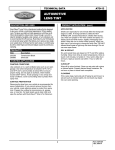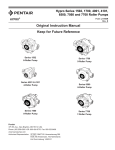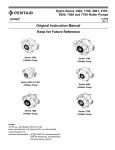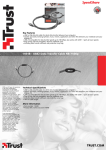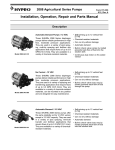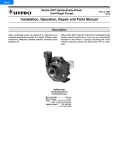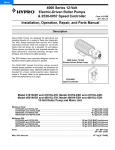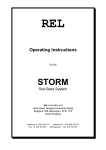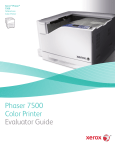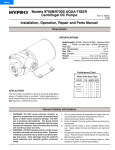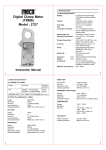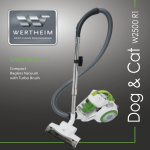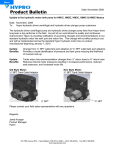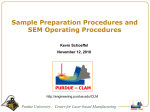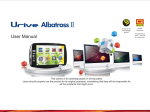Download the Installation, Operation, Repair and Parts Manual
Transcript
Series 7560 Hydraulically-Driven Roller Pumps Form L-1488 1/07 Installation, Operation, Repair and Parts Manual Description Hypro roller pumps are designed for agricultural and industrial spraying and transfer of a variety fluids. These include insecticides, herbicides, emulsives, aromatic solvents, liquid fertilizers and many other liquids. The economical rotary-action roller principle requires no check valves while providing positive displacement characteristics with less friction and lower starting torque than other pumps. Construction features include a Cast Iron, Ni-Resist or Silver CastTM body, Super Rotor, 416 stainless steel shaft, sealed factory-lubricated ball bearings, cartridge-type lip seals of Viton or Buna-N, and versatile Super Rollers. (Super Rollers feature the life of polypropylene and the chemical resistance of nylon.) The hydraulically-driven roller pump can be conveniently mounted anywhere and hooked up to system hydraulics, eliminating the need for a PTO or a gas engine to drive the pump. SERIES 7560 8-ROLLER PUMP Max. Flow Rate: ..........................................20 gpm Max. Continuous Pressure: .........................100 psi Max. Intermittent Pressure: .........................300 psi Max. Hydraulic Flow: ..................................12 gpm Max. Hydraulic Pressure: .........................3000 psi Ports: ..................................3/4" NPT Inlet & Outlet Hydraulic Ports: ..........7/8"-14 O-ring Inlet & Outlet General Safety Information The following attention notices are used to notify and advise the user of this product of procedures that may be dangerous to the user or result in damage to the product. 4. Release all pressure within the system before servicing any component. Notes are used to notify of installation, operation, or maintenance information that is important but not safety related. 6. Secure the outlet lines before starting the pump. An unsecured line may whip, causing personal injury and/or property damage. 5. Drain all liquids from the system before servicing any component. Flush with water. 7. Check hose for weak or worn condition before each use. Make certain that all connections are tightly secured. Caution is used to indicate the presence of a hazard, which will or can cause minor injury or property damage if the notice is ignored. 8. Periodically inspect the pump and the system components. Perform routine maintenance as required (See Repair Instructions). Warning denotes that a potential hazard exists and indicates procedures that must be followed exactly to either eliminate or reduce the hazard, and to avoid serious personal injury, or prevent future safety problems with the product. 9. Use only pipe, hose and fittings rated for the maximum psi rating of the pump. 10. Do not use these pumps for pumping water or other liquids for human or animal consumption. 11. Use a pressure relief device on the discharge side of the pump to prevent damage from pressure buildup when the pump discharge is blocked or otherwise closed and the power source is still running. Danger is used to indicate the presence of a hazard that will result in sever personal injury, death, or property damage if the notice is ignored. 12. Never pump acids (i.e. acid fertilizer) with Super Rollers! When pumping acidic fertilizer, Hypro recommends only the Silver Series castings and Teflon rollers, or use one of Hypro's poly centrifugal pumps. Do not pump flammable or explosive fluids such as gasoline, fuel oil, kerosene, etc. Do not use in explosive atmospheres. The pump should be used only with fluids that are compatible with the pump component materials. Failure to follow this notice can result in severe personal injury, death, and/or property damage and will void the product warranty. 13. Never run the pump faster than maximum recommended speed. 14. The sound pressure level of the pump is 82 dBA. Observe all safety precautions when operating the pump within close proximity for extended periods by wearing hearing protectors. Extended exposure to elevated sound levels will result in permanent loss of hearing acuteness, tinnitus, tiredness, stress, and other effects such as loss of balance and awareness. 1. Do not pump at pressures higher than the maximum recommended pressure. 2. Maximum liquids temperature is 140° F. 3. Disconnect the power before servicing. Hazardous Substance Alert Never use your hand to check the condition of hydraulic lines or hoses. If hydraulic fluid penetrates the skin, get medical help immediately. Failure to get proper medical help may result in loss of limb or life. The safest way to check hydraulic lines or hoses is by holding a piece of cardboard next to the hydraulic line or hose. 1. Always drain and flush pump before servicing or disassembling for any reason. 2. Always drain and flush pumps prior to returning unit for repair. 3. Never store pumps containing hazardous chemicals. 4. Before returning pump for service/repair, drain out all liquids and flush unit with neutralizing liquid. Then, drain the pump. Attach tag or include written notice certifying that this has been done. It is illegal to ship or transport any hazardous chemicals without United States Environmental Protection Agency Licensing. The sound pressure level of the pump is 80dBA. Observe all safety precautions when operating the pump within close proximity for extended periods of time by wearing hearing protectors. Extended exposure to elevated sound levels will result in permanent loss of hearing acuteness, tinnitus, tiredness, stress and other effects such as loss of balance and awareness. 2 System Information NOTE: Use only pipe, fittings, accessories, hose, etc. rated for the maximum pressure rating of the pump. 1. Select adequate size drive unit to avoid overloading. Avoid unnecessary restrictions in the line such as elbows, check valves, and all extraneous curves and bends. 2. Avoid using looped sections of tubing or pipe which might permit air to become trapped. 7. Never attach an agitator or any restriction to a bypass line of a pressure relief device because system damage may occur. Figure 1 Typical System Installation 3. Use pipe joint sealant on pipe threads to assure watertight connections. Bypass line 4. Selection of the right type and size of hose is vital to good performance. Be sure to hook up the lines to the proper ports on the pump. 5. Always use a good quality suction hose (one or two braid reinforced hose to prevent collapse) of at least the same diameter as the inlet port of the pump. If the suction (inlet) hose is more than four feet long, then use the next larger size. 6. A strainer should be installed in the suction line. Clean the strainer as soon as it becomes clogged. Operation and Maintenance WARNING: Never pump corrosive or abrasive liquids as these will cause rapid wear or deterioration of body, rotor, shaft and seals in the pump. The pump should be used only with liquids compatible with pump component materials. Never exceed maximum specified rpm and pressure. Never run pump dry. Failure to follow this warning will void the product warranty. Flush the Pump After Each Use Priming the Pump To Prevent Corrosion To help prime the pump keep the inlet or suction line as short as possible with a minimum of bends, elbows and kinks. Make sure all connections are tight and do not leak air. Make sure line strainer is free of debris. If pump does not self-prime disconnect suction hose, fill with water and reconnect to liquid source. Often a squirt of oil into the ports of the pump will seal clearances and help priming. Care of the Pump Hypro roller pumps are all carefully machined to close tolerance - high pressure operation depends on closefitting parts. Proper care and maintenance will keep your pump wear at a minimum and will keep it running smoothly and trouble free for a long time. 3 One of the common causes of faulty pump performance is “gumming” or corrosion inside the pump. This prevents the rollers from moving freely in their rotor slots. Flush the pump with a solution that will neutralize liquid pumped, mixed according to manufacturer’s directions. After cleaning pump as above, flush it with a 50-50 solution of permanent type automobile antifreeze (containing a rust inhibitor) and water. A rust inhibitor can also be squirted into the ports of the pump. Turn shaft several times to draw protective liquid through pump and coat entire inner surface. Drain pump and plug ports to keep out air during storage. For short periods of idleness, noncorrosive liquids may be left in the pump, but air must be kept out. Plug ports or seal port connections. Rotation Pump rotation must be the same as shown by the arrows on the pump. Facing the shaft end of the pump, the suction port is on your right and the shaft must turn clockwise. If reverse rotation is desired, rotor and shaft assembly must be reversed so that the shaft extends through the endplate. See Reversing Rotation section for proper procedure. Repair Instructions To Take the Pump Apart 1. Remove the mounting flange and hydraulic motor from the pump shaft. 2. File off any burrs on the pump shaft. 3. Using a screwdriver, pry off the bearing cover on the End plate and pump body 4. Remove the end plate bolts. 5. Support the pump at its ports in an end plate support fixture with the end plate down. Use wood blocks for Series 1500, 1700 and 4001/4101. Place on press bed. Center press on pump shaft and apply pressure to press the pump apart. (See Figure 13). Figure 15 Figure 16 While the Pump is Apart Carefully inspect all parts for wear, such as: • Undersize or swollen rollers, in both length and diameter. • Worn seals. • Worn shaft at drive end, and pitted or grooved at the seal area. • Rough bearings and loss of grease from the bearings. • Undersize rotor and/or worn roller slots. Figure 13 • Excessive wear in body – both on inside diameter and at back face. • Body cracks at the bolt holes and at the o-ring sealing area. Figure 14 • End wear (body, end plate, and rotor). 6. With the rollers exposed, remove them – examining each one carefully for excessive wear. When replacing damaged rollers, always replace the full set. • Proper size o-ring in the end plate. After the above parts have been checked and the various points have been considered, you may decide if the pump is repairable. When worn parts have been replaced, always take up the end clearance by lightly sanding the end plate and matching body surface (See Figure 17). NOTE: End clearance should not be more than .004 inches. 7. To remove the rotor with shaft from the end plate – support the end plate in an end plate support fixture with the rotor down. Center the bearing disassembly tool or 3/8" bolt on pump shaft. Apply pressure to press shaft out of ball bearing (See Figure 14). 8. To remove the ball bearing – place the end plate in a end plate support fixture with the front of the end plate down (See Figure 15). Center bearing support tool and slowly press bearing out of casting. Repeat procedure to remove bearing from pump body (See Figure 16) using body support fixture. Inspect Inside of End Plate If a groove is noticeable, the end plate should be resurfaced by rubbing it on a sheet of 80-grit emery paper (placed on flat surface) until all trace of wear has been removed. Rotate the end plate frequently to remove evenly the same amount of metal over the entire surface. NOTE: This surface of the end plate must be perfectly flat. If attempt has been made to pry pump apart with a screwdriver, file off all nicks, burrs and other damage marks around the bolt holes. 9. After removing the ball bearing, check the seals in both end plate and pump body. If wear is evident or leakage has been noticed, punch the seals out with a screwdriver and hammer. Seals cannot be removed without damaging them. 10. To press the shaft out of the rotor, first carefully wash the rotor and shaft with kerosene – removing all traces of rust and other foreign matter. Use steel wool or emery cloth, rinsing parts afterward to wash off all emery dust. Remove the Allen set screw. Support the rotor in the press through the slot in the base and press shaft through. 4 Figure 17 Re-Assembly Do not machine the body casting clean. A more satisfactory job can be done by hand cleaning with an emery cloth. Wettable talc powder mixture (5 lbs. powder to 5 gallons water) may be used for breaking in a repaired pump, if pump appears to be binding. Run pump for about 5 minutes. This will also serve to clean and remove corrosion from the pump. Follow with a clear rinse, and protect from rust. (See Maintenance.) Replace Seals and Bearings Carefully place the seal in the pump body with crimped side down. Press the seal to the bottom of the cavity, using the stepped end of the Bearing & Seal Assembly Tool (Figure 18). Then put the bearing in position in the pump body and press into place with counter bored end of Bearing & Seal Assembly Tool (Figure 19). Repeat the above procedure with the end plate. Seat the o-ring in the groove. If necessary, make sure the o-ring stays in place by stretching it. 2. 3. Figure 18 Figure 19 Remove the assembled portion from the arbor press and invert it on the press table with the Bearing Support Tool under the bearing. Then place rollers in the roller slots as close to center of rotor as possible. Place the pump body over rotor and shaft, and carefully ease the end of the shaft past the lips of the seal in pump body (Figure 21). Center Bearing Support Tool with counter bored end down on inner race of ball bearing, and slowly press the pump body down to fit the end plate (Figure 22). Turn pump over; line up bolt holes and replace assembly bolts. Alternately and evenly tighten the bolts as shown (Figure 23). NOTE: After bolts have been tightened, check to see if rotor is centered in pump case. Try to turn the pump shaft, using a crescent wrench on the shaft as a lever. Assemble Rotor & Shaft To Endplate 1. Install the shaft rotor assembly by carefully pushing the short end of the shaft rotor assembly through the shaft seal into the end plate. Place in the arbor press with the drive end of the shaft pointed down. Use the Bearing Support Tool on top of the bearing and press the assembly together. (Figure 20). Leave just enough clearance between the rotor and end plate so that rotor can be turned by hand. If it turns too freely, sand a little more off the body end that faces the end plate. You should notice a slight drag, but be able to turn shaft with an adapter on it by hand. The “slight drag” will wear off after the pump has been used a short time. Installing new rollers, seals, bearings and shafts will not prove entirely satisfactory for volume and pressure unless end clearance is taken up. Figure 22 Center Rotor in Pump Case Figure 23 If pump turns hard: 1. Place short brass rod (or hardwood dowel) against end of shaft (Figure 24). Center rod on shaft (not on bearing). Tap lightly with hammer. Try turning rhaft again. Figure 24 Figure 20 2. If this fails to center the Rotor to where it can be turned freely — tap other end of shaft, protecting it as above. When the shaft can be turned by hand — using wrench as above — it is not binding. Figure 21 NOTE: If the end plate has been resurfaced, the body face must also be resurfaced to allow for material taken off the end plate. Follow same procedure as above with emery cloth. Before new parts are installed, all burrs should be removed – particularly in the rotor slots and body. 5 3. If the pump binds within and tapping does not free it, it may be necessary to “run the pump in” to wear off high spots. Use talc solution mentioned earlier. Check pump frequently during run in. Troubleshooting Symptom Pump does not prime. Probable Cause(s) Corrective Action Obstruction in suction line. Inspect hose for obstruction such as debris or loose inner liner. Leak in suction line. Suction hose sucked to bottom or side of tank. Rollers stuck in pump. Pump seals leaking air. Loss of pressure. Pump turning in wrong direction. Disassemble pump and inspect rollers. Replace seals. Correct rotation of pump (See Reversing Pump). Check strainer and clean it regularly. Air leak in inlet side plumbing. Check hose and connections for leaks. Use pipe joint sealant and retighten connections. Kinked or blocked suction hose. Faulty gauge. Pump seals leak air. Inspect suction hose and repair as necessary. Check relief valve and correct setting or replace weakened spring. Replace gauge. Replace seals. Nozzle orifices worn. Hydraulic system overheating. Cut a notch or “V” in end of suction hose. Clogged suction strainer. Relief valve setting too low or weakened spring. Pump will not turn. Check hose and fittings for leaks, and correct. Replace nozzles. Pump worn. Repair pump (See Repair Instructions). Solid object lodged in pump. Disassemble pump and remove objects. Corrosion (rust), scale or residue. Improper hydraulic motor size. Insufficient hydraulic hose size. 6 Loosen end plate bolts. Squirt oil into ports to help free rotor. Retighten bolts. Refer to Pump Selection Guide to determine proper size for your hydraulic system. Check hydraulic hose size. Hose should be at least 1⁄2" (12.7 mm). For large open-center systems, 3⁄4" (19.05 mm). Models 7560C-GM30, 7560N-GM30 and 7560XL-GM30 3 2 20 4 19 18 6 1 8 5 7 10 9 13 17 14 6 15 7 11 12 16 Ref. Qty. Part No. Req'd. Number Ref. Description Qty. Part No. Req'd. Number Description 1 1 1 2 1 1 1 1 0154-7500C 0154-7500N 0154-7500X 0510-7500 Body (Cast Iron) Body (Ni-Resist) Body(SilverCast) Shaft 9 10 11 12 1 1 1 1 1410-0111 1610-0005 0750-7500C 2500-0028 Spacer Key Mounting Flange Hydraulic Motor 4 4 4 5 1 1 1 1 0254-7500C 0254-7500N 0254-7500X 1610-0059 End plate (Cast Iron) End plate (Ni-Resist) End plate (SilverCast) Key 17 18 19 20 20 20 3 1 1 1 1 1 11621 0403-7500P 1720-0014 0308-7560C 0308-7560N 0308-7560X Bolt Rotor (Phenolic) O-ring Rotor (Cast Iron) with shaft Rotor (Ni-Resist) with shaft Rotor (SilverCast) with shaft 3 3 3 3 6 6 7 8 8 8 8 8 2 2 2 1 1005-0004 1002-0004 1052-0004 1055-0004 2112-0003 2112-0001 2008-0001 2300-0020 13 14 15 16 Super Roller (Standard) Polypropylene Roller (Optional) Buna-N Roller (Optional) Teflon Roller (Optional) Viton Seal (Standard) Buna-N Seal (Optional) Seated Ball Bearing Bearing Cover Repair Parts Kit No. 3430-0381 Consists of: (8) Ref. 3 Super Rollers, (1) Ref. 19 O-Ring and (2) Ref. 6 Viton Seals. Repair Parts Kit No. 3430-0167 Consists of: (8) Ref. 3 Polypropylene Rollers, (1) Ref. 19 O-Ring and (2) Ref. 6 Viton Seals. Repair Parts Kit No. 3430-0622 Consists of: (1) Ref. 18 Phenolic Rotor, (1) Ref. 2 Shaft and (1) Ref. 10 Key. Flange Kit No. 3430-0636 Consists of: (1) Ref. 11 Mounting Flange, (1) Ref. 13 Coupler, (1) Ref. 9 Spacer, (3) Ref. 15 Bolt, (2) Ref. 16 Nut, (2) Ref. 17 Bolt and (1) Ref. 10 Key. 7 1 3 2 2 0524-2500 2210-0004 2210-0063 2250-0082 Coupler Bolt Bolt Nut Limited Warranty on Hypro Roller Pumps Hypro warrants to the original purchaser of its products (the “Purchaser”) that such products will be free from defects in material and workmanship under normal use for the period of one (1) year for all products except: oil crankcase plunger pumps will be free from defects in material and workmanship under normal use for the period of five (5) years, and accessories will be free from defects in material and workmanship under normal use for the period of ninety (90) days. In addition, Hypro warrants to the purchaser all forged brass pump manifolds will be free from defects in material and workmanship under normal use and from damage resulting from environmental conditions for the life of the pump. “Normal use” does not include use in excess of recommended maximum speeds, pressures, vacuums and temperatures, or use requiring handling of fluids not compatible with component materials, as noted in Hypro product catalogs, technical literature, and instructions. This warranty does not cover freight damage, freezing damage, normal wear and tear, or damage caused by misapplication, fault, negligence, alterations, or repair that affects the performance or reliability of the product. THIS WARRANTY IS EXCLUSIVE. HYPRO MAKES NO OTHER WARRANTY, EXPRESS OR IMPLIED, INCLUDING BUT NOT LIMITED TO ANY WARRANTY OF MERCHANTABILITY OR FITNESS FOR A PARTICULAR PURPOSE. Hypro’s obligation under this warranty is, at Hypro’s option, to either repair or replace the product upon return of the entire product to the Hypro factory in accordance with the return procedures set forth below. THIS IS THE EXCLUSIVE REMEDY FOR ANY BREACH OF WARRANTY. IN NO EVENT SHALL HYPRO BE LIABLE FOR ANY INCIDENTAL OR CONSEQUENTIAL DAMAGES OF ANY KIND, WHETHER FOR BREACH OF ANY WARRANTY, FOR NEGLIGENCE, ON THE BASIS OF STRICT LIABILITY, OR OTHERWISE. Return Procedures All pumps or products must be flushed of any chemical (ref. OSHA Section 0910.1200 (d)(e)(f)(g)(h) and hazardous chemicals must be labeled before being shipped* to Hypro for service or warranty consideration. Hypro reserves the right to request a Material Safety Data sheet from the Purchaser for any pump or product Hypro deems necessary. Hypro reserves the right to “disposition as scrap” pumps or products returned which contain unknown substances, or to charge for any and all costs incurred for chemical testing and proper disposal of components containing unknown substances. Hypro requests this in order to protect the environment and personnel from the hazards of handling unknown substances. For technical or application assistance, call the Hypro Technical/Application number: 1-800-445-8360. To obtain service or warranty assistance, call the Hypro Service and Warranty number: 1-800-468-3428; or call the Hypro Service and Warranty FAX: (651) 766-6618. Be prepared to give Hypro full details of the problem, including the following information: 1. Model number and the date and from whom you purchased your pump. 2. A brief description of the pump problem, including the following: • Liquid pumped. State the pH and any non-soluble • Drive type (gas engine/electric motor; direct/belt drive; materials, and give the generic or trade name. tractor PTO) and rpm of pump. • Temperature of the liquid and ambient environment. • Viscosity (of oil, or other than water weight liquid). • Suction lift or vacuum (measured at the pump). • Elevation from the pump to the discharge point. • Discharge pressure. • Size and material of suction and discharge line. • Type of spray gun, orifice size, unloader/relief valve. • Size, type, and mesh of the suction strainer. Hypro may request additional information, and may require a sketch to illustrate the problem. Contact the factory to receive a return material authorization before sending the product. All pumps returned for warranty work should be sent shipping charges prepaid to: HYPRO Attention: Service Department 375 Fifth Avenue NW New Brighton, Minnesota 55112 *Carriers, including U.S.P.S., airlines, UPS, ground freight, etc., require specific identification of any hazardous materials being shipped. Failure to do so may result in a substantial fine and/or prison term. Check with your shipping company for specific instructions. Printed in USA 2007 Hypro








